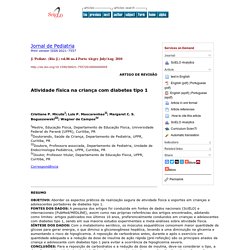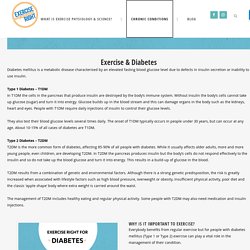

Management of diabetes mellitus in children and adolescents: engaging in physical activity. Resources to Guide Exercise Specialists Managing Adults with Diabetes. Diabetes and exercise. Benefits of exercise Exercise has benefits for everyone, including people with diabetes, especially when combined with healthy eating.

Benefits of exercise According to Australia’s Physical Activity and Sedentary Behaviour Guidelines, it’s important to accumulate 2½ to 5 hours per week of moderate exercise or 1¼ to 2½ hours of vigorous exercise to obtain health benefits. This can be broken up throughout the week to suit your needs. Exercise helps to: improve mood and sleep improve muscle strength and bone mass lower blood glucose levels (BGLs) lower cholesterol and blood pressure improve heart and blood vessel health maintain or achieve a healthy body weight reduce stress and tension improve mental health. If you are at risk of type 2 diabetes, exercise can be part of a healthy lifestyle that can help to reduce this risk. Physical activity fact sheet – NDSS. This fact sheet is available in two formats.

You can download and print out the PDF version Or you can read it as a website page below. Regular physical activity is one of the most important things you can do to improve your health and help manage your diabetes. The more physically active you are, the greater the health benefits will be. However, any activity, even at a slow pace, can have health benefits, and some activity is better than none at all. Benefits of physical activity Physical activity plays a vital role in helping the body use glucose as fuel for the working muscles, which in turn lowers blood glucose levels. When the body starts to exercise, the muscles need energy to move. There are plenty of other benefits of regular physical activity, including: Types of physical activity Doing a combination of different types of physical activity has proven benefits for managing diabetes.
Exercise – Diabetes Australia. Everybody benefits from regular exercise.

If you have diabetes, or are at risk of diabetes it plays an important role in keeping you healthy. Benefits For a person with diabetes exercise helps: Insulin to work better, which will improve your diabetes managementMaintain a healthy weightLower your blood pressureReduce your risk of heart diseaseReduce stress. Warning- Don’t take part in strenuous physical activity if you are feeling unwell or have ketones present in your blood or urine. Exercise programs Before commencing a regular exercise program see your doctor for a full medical examination. If you have any diabetes complications like retinopathy, nephropathy, you should talk to your doctor or an accredited exercise physiologist before you start increasing the intensity of your exercise.
What exercise can I do? Anything that gets you moving. Guidelines for Queensland Schools : Students with Diabetes. Physical activity in children with type 1 diabetes. Atividade física na criança com diabetes tipo 1 Cristiane P.

MiculisI; Luis P. MascarenhasII; Margaret C. S. BoguszewskiIII; Wagner de CamposIV IMestre, Educação Física, Departamento de Educação Física, Universidade Federal do Paraná (UFPR), Curitiba, PR IIDoutorando, Saúde da Criança, Departamento de Pediatria, UFPR, Curitiba, PR IIIDoutora, Professora associada, Departamento de Pediatria, Unidade de Endocrinologia Pediátrica, UFPR, Curitiba, PR IVDoutor, Professor titular, Departamento de Educação Física, UFPR, Curitiba, PR Correspondência OBJETIVO: Abordar os aspectos práticos da realização segura de atividade física e esportes em crianças e adolescentes portadores de diabetes tipo 1. Palavras-chave: Diabetes melito tipo 1, exercício, hipoglicemia, criança, adolescente. Introdução A prevalência do DM1 vem aumentando consideravelmente em todo o mundo, sendo mais acentuada nos países nórdicos e muito baixa nos países asiáticos4. Por que fazer exercício físico? O medo da hipoglicemia. Type 1 diabetes in children and adolescents - physical activity.
Diabetes and Exercise - What you need to know! Right Professional GP/Doctor Before beginning an exercise program, you should undergo an extensive medical evaluation by your doctor to identify any diabetic related complications.

Accredited Exercise Physiologist (AEP) Assessment and evaluation of your body is also recommended by an accredited exercise physiologist. An AEP can then deliver an expertly prescribed exercise program tailored to your individual requirements and goals. Right Place Climate controlled environment Often thermoregulation in hot or cold environments is impaired for those with diabetes. Right Time. Diabetes and Exercise. Diabetes mellitus (Diabetes) is a chronic medical condition where there too much glucose in the blood due to the absence of insulin or inability to properly use insulin.

The recommended range for blood glucose is between 4.0-8.0mmol/L. Blood glucose levels above or below this range are termed hyperglycaemia and hypoglycaemia, respectively. Diabetes management usually consists of a multidisciplinary team including a GP, endocrinologist, diabetes educator and dietitian. Sport & Exercise - Diabetes Australia. Keeping active and taking part in sport is an important part of your diabetes management (as well as being a typical Aussie pastime).

Try and make time for regular physical exercise – whether it’s at the gym, going for a walk with the dog, or kicking a footy on the oval with friends. What you’ll find here Why Be Active? Things to ConsiderSuitable Types of ExerciseSports Freak? More Information Why Be Active? Being active can help you: Maintain a healthy weightSleep betterStay positive and feel good about yourself Meet new friendsRelieve stressBetter manage your diabetes Back to top Things to Consider There are some things you need to consider about exercising and diabetes.